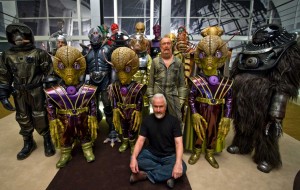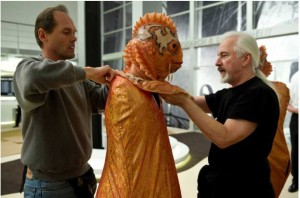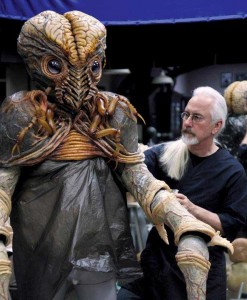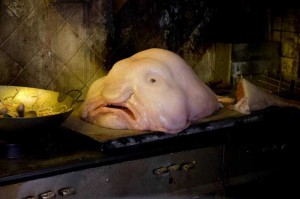 With seven Oscars and numerous prestigious projects to his credit, Rick Baker has nothing left to prove and little that he has not already accomplished in his career. In fact, many people in the film business mistakenly think he has retired. But in his words, he has merely become more selective in the projects that he chooses. Thus, in the past ten years, after working back-to-back-to-back on the huge films The Grinch, The Planet of the Apes and Men in Black II, he took something of a break and did not fully engage his massive Cinovation facility in Glendale, California.
With seven Oscars and numerous prestigious projects to his credit, Rick Baker has nothing left to prove and little that he has not already accomplished in his career. In fact, many people in the film business mistakenly think he has retired. But in his words, he has merely become more selective in the projects that he chooses. Thus, in the past ten years, after working back-to-back-to-back on the huge films The Grinch, The Planet of the Apes and Men in Black II, he took something of a break and did not fully engage his massive Cinovation facility in Glendale, California.
Indeed, on a late March afternoon, Cinovation is relatively quiet, especially considering its daunting size. This newest version of Cinovation, which Baker moved into when he was creating the first Men in Black, took three years to finalize due to the inclusion of various contractors and the acquisition of permits. From the outside, it looks like it might be a public works building, but that all changes when you step inside the main door. First, one sees gorgeous hand renderings of many classic movie monsters, courtesy of former Cinovation art director Aaron Sims. Stepping onto the main floor, one notes a lengthy tall space containing various technical departments, from moldmaking and foam running to creating original sculptures. Near a large loading dock with industrial doors, Baker has built the façade of a classic gothic castle nestled above a graveyard replete with tombstones dedicated to notable horror actors and personnel. Within the second floor of the castle, one walks down a narrow corridor that might be a replica of the one that Bert Lahr’s double ran down in The Wizard of Oz, which is a Baker favorite. On one side, Baker has a private makeup studio from which he can see out onto a gothic horror sky backdrop reminiscent of Universal’s Frankenstein. On the other side of the castle is a large display room, around which are set up lifelike busts from some of Baker’s most famous films: the seven Oscar-winning projects are represented, in addition to many Men in Black creations.
Despite Cinovation’s relative current calm, several times in the past decade, Baker has gotten his studio up and running full steam for such films as The Ring, Norbit and The Wolfman. And just recently, he was coaxed back into designing and supervising the creature effects on a big production once again with the inevitable sequel, Men in Black III. Given all that he has achieved, it might be a surprise to some to realize that it is still that youthful first desire to first work in this chosen field that keeps Baker excited about the business. “I was of that first generation that call themselves Monster Kids,” he said. “We saw the Universal horror films on TV and Famous Monsters magazine came out. I read that it was somebody’s job to make monsters. I said, ‘You can do that as a job?’ Then I started doing it as a hobby, hoping that I could turn it into a job.”
 Of course, he started at a very young age in the 1950s and moved onto more serious projects in the 1960s. By the 1970s, Baker was working full-time as his own boss, creating wondrous creatures and makeup characters for films. “I like to make things,” he said matter-of-factly. When prompted as to whether his creations come from a dark side, he stated, “I am attracted to some weird dark things, but I don’t see them that way. I have a skeleton collection, but it’s the armature for what [living] things are made of. I have a number of human skulls – no two are alike like since no two people are alike. I found this catalog with animal and human skulls and skeletons – all of the human skulls were from India. I find it fascinating more than morbid. I am squeamish – I don’t like to see people hurt or see blood. That stuff doesn’t appeal to me. I’ve done gory things in movies and monster gore is one thing, but I don’t care for people hurting other people.”
Of course, he started at a very young age in the 1950s and moved onto more serious projects in the 1960s. By the 1970s, Baker was working full-time as his own boss, creating wondrous creatures and makeup characters for films. “I like to make things,” he said matter-of-factly. When prompted as to whether his creations come from a dark side, he stated, “I am attracted to some weird dark things, but I don’t see them that way. I have a skeleton collection, but it’s the armature for what [living] things are made of. I have a number of human skulls – no two are alike like since no two people are alike. I found this catalog with animal and human skulls and skeletons – all of the human skulls were from India. I find it fascinating more than morbid. I am squeamish – I don’t like to see people hurt or see blood. That stuff doesn’t appeal to me. I’ve done gory things in movies and monster gore is one thing, but I don’t care for people hurting other people.”
In 1997, when he had completed a sequential string of amazing projects including Ed Wood and The Nutty Professor both of which brought him Oscars, Baker joined the team for the first Men in Black movie, which would ultimately bring him another Oscar win. But at the very beginning, the movie and how it would be made were a total mystery to all involved. “On the first Men in Black, nobody had any idea what the movie would be,” he explained. “What I did like was that I was very much a collaborator on that film. At first, I didn’t think there were enough aliens in the script. I thought it should be better, so I suggested things, and they went for it.”
Although Men in Black II was somewhat less awe-inspiring than the first film, the prospect always existed for a third film, but Baker had moved onto other projects, though fewer and farther between. “I am trying to be more selective about what I do now,” he said. “Before, I took films to keep people [in my studio] employed. I don’t know how many years I have left, and I don’t want to be doing things I don’t want to do. A film is your life, doing 18-20 hour days a lot of times. I’ve never considered myself retired. I took some time off and tried to be selective.”
 Finally, director Barry Sonnenfeld who directed the first two Men in Black films, asked Baker to be part of a new Men in Black movie. “Of course I would love to do it,” Baker offered. “We get to do almost everything I’ve done in my whole career in the Men in Black films – normal makeups, fake heads, animatronic things, puppets, and get to collaborate with the filmmakers. I was really happy to be part of it.”
Finally, director Barry Sonnenfeld who directed the first two Men in Black films, asked Baker to be part of a new Men in Black movie. “Of course I would love to do it,” Baker offered. “We get to do almost everything I’ve done in my whole career in the Men in Black films – normal makeups, fake heads, animatronic things, puppets, and get to collaborate with the filmmakers. I was really happy to be part of it.”
Similar to the massive organizational problems of other big studio projects, the script to Men in Black III was unfinished when Baker came aboard. “It is tough and makes it difficult not having a finished script,” he said. “When Barry contacted me, he gave me a script that I thought was great, [but] they started rewriting it. We knew that there would be aliens. They wrote this really cool scene with a police lineup and Will Smith. We designed and started making aliens, and then they would write that scene out. The film was entirely shot in New York and we were based in my studio [in California]. I didn’t want to set up in some crappy place in NY without ventilation. And they wanted to use local people, and we weren’t going to face cast them until we were there.”
As a solution to not having actors for whom to prepare complicated makeups, Baker strategized a new system. “I came up with a mix and match thing with different brows, fins, and different parts, so we could make an alien on the spot,” he described. “We could get an actor that we haven’t seen before and put the different pieces together. We came up with some interesting aliens by putting together different parts like a Mr. Potato Head-type thing. Some days we didn’t know how the aliens were going to be until we put it together. The guys working for me were kind of negative about it: ‘That is not the right way to do it.’ But I thought it would be fun; run stuff out of old molds that we have and start putting pieces together. I did an alien out of old molds and cotton and latex that everyone thought was fun. I like fabricating things too.”
A new element for Men in Black III that has been teased in trailers includes a time-travel aspect to the script. As such, Baker went with that concept in his designs. “I pride myself in trying to pick the right thing for the film that I’m working on,” he said. “One of the things on this movie that was so cool is there is this time-travel element. There should be a difference between aliens now and retro aliens from 1969. I got to pay homage to [film and TV] aliens from the 1950s and 1960s.” As a result, the observer need only look closely at the 1969 scenes to see such creations.
Baker also received inspiration from his director. “Barry found this picture of this strange lumpfish,” he said. “It was cool and he wanted to have that in the scene. We made it out of silicon gel like breast implants are made out of. “
 One amusing account reveals what happened to that creature on set. “I am watching the monitor and on the first take Tommy [Lee Jones] smashed the head and it looked like he went way into it,” Baker observed. “He was going way farther in there than he should. He did it with such force that he broke the fiberglass core. There was a sharp silicone piece protruding out – I said, ‘Tommy, you can’t do that.’ When I realized that Tommy Lee Jones was holding it, we made a stunt version. Tommy breaks things instantly. Tommy also hit a guy in the face with a solid silicone spiky bulba prop that we made. He was really hitting him with it.”
One amusing account reveals what happened to that creature on set. “I am watching the monitor and on the first take Tommy [Lee Jones] smashed the head and it looked like he went way into it,” Baker observed. “He was going way farther in there than he should. He did it with such force that he broke the fiberglass core. There was a sharp silicone piece protruding out – I said, ‘Tommy, you can’t do that.’ When I realized that Tommy Lee Jones was holding it, we made a stunt version. Tommy breaks things instantly. Tommy also hit a guy in the face with a solid silicone spiky bulba prop that we made. He was really hitting him with it.”
In fact, many of the Chinese Restaurant sequence aliens do have a sea creature appearance. “It had a Creature from the Black Lagoon influence,” Baker stated. “Fish on our planet have a very alien deep-sea look. We draw on a lot of things from this planet – lizardy things and fish things — and crustaceans.”
When prompted about applying his own personal stamp on his films, Baker is reflective. “I think there is definitely a ‘Rick Baker style,’” he commented. “I am working on a book about my career, starting back from when I was five years old until now. It’s been an interesting journey to see pictures of stuff that I’ve done over the years. I definitely like hairy things and do a lot of things with a lot of angles – because it looks scarier. I can tell my stuff. Not as much as I used to, but that came out of my fascination with monsters and trying to fool people with my makeup. I wanted people to believe that what I was doing was real.”
Of course, one constant creature that Baker has been called on to realize throughout his now six-decades-along career is the gorilla. “That was something that I could do with my makeup skills,” he said. “From my first gorilla suit, it wasn’t that good, but I wanted people to feel as though it was a real gorilla. The more I found out about the animals, in so many ways, they are better than human beings. They are vegetarians and have great family. I wanted to build an absolutely real gorilla – when I did Gorillas in the Mist, they wanted to intercut my fake apes with the real ones. I told them they couldn’t do that. When I did Mighty Joe Young, I thought it was even better. Then Planet of the Apes came along.”
“For King Kong,” he continued, “I played the gorilla in the Dino De Laurentiis one. I said that they would get some idiot and put him in a gorilla suit. It was a disappointing thing, but they wanted a Hollywood gorilla. I couldn’t build what I wanted to build. I knew the World Trade Center well because I spent many a day and night on miniature versions of those buildings.”
As to whether Men In Black III will live up to the promise set forth by the first film, Baker noted that the nature of this particular beast is steadfastly challenging. “It‘s moviemaking – movies are difficult to do,” he said. “That they get completed and every once in a while, they are good. It’s a miracle. I had a blast. When I thought this stuff was dead, I was very appreciative that we could do it again, making 127 aliens. I had a lot of my old crew back. Back with Barry and the whole gang was very much like time travel. I’m sitting in a room with the cast and crew talking about a Men in Black movie. It was a strange, déjà vu feeling.”
Certainly, in addition to Baker’s practical creatures, one constant in a Men in Black film will be computer-generated imagery. But Baker does not seem at all bitter about its inclusion in a film where his practical effects designs are so prominent. “I embrace computer-generated effects,” he said. “I have been doing my designs digitally for 23 years. From the real world when you are doing a sculpture, you think the face should be longer and have to add more clay. In the computer, you can click a button. I totally loved that. My designs got better. The computer made it so you can just try anything.”
Baker’s adoption of computer techniques in his designs has not only made his work freer in his own shop, it has also been useful to digital artists working on the same project. “One of the aliens, this Boris character, the weasel, I sculpted in Z-brush,” he remarked. “I gave the digital file to the Sony ImageWorks people, and they used it to do the computer model. We made a 3D model that matches the CG one.”
When asked about negatives to the computer revolution for creating characters in live-action films, Baker pointed to producers’ over-reliance on the one technique. “What I don’t like is that it’s the answer for everything,” he said. “’Fix it in post.’ It’s hard to make decisions. It’s one of the hard things about what I do: it takes so long [that] I need the director to decide at a certain point. Often, they will make a decision to get me off of their back. It happens all of the time in movies now. ‘We’ll make it a computer thing and we’ll think about it later.’”
Men in Black III had a new aspect to the production for the film series: it was geared towards a 3D presentation. But Baker was unfazed by the process. “It being 3D didn’t change anything for me,” he said. “The digital technology did. I’ve known [visual effects supervisor] Ken Ralston, who did the digital effects, since I was 17. We hoped that some day we would work on movies. We tended to overbuild from the other Men In Black movies. We had animatronic things and spare parts and different heads. Having done two movies, I’d say, ‘let’s not spend a lot of money and time putting eye-blinks in a head – Ken can put a digital eye-blink pretty easily.’ The main character, Boris, was designed as a makeup but we used digital technology with him. But I still think that there is a real magic that happens when you have an actor in a makeup. He sees what that other face is and gives a performance.”
Considering the breadth and scope of his career, Baker, now 61, seems pleased with his overall body of work. “If I was to die today, I’d be happy with what I’ve done,” he said. “I’ve accomplished most of what I wanted to in my life. I would like to do a big fantasy film like The Wizard of Oz; Grinch got me into that territory. I would still like to do more old-school horror films like Frankenstein. But I don’t know if that can be improved upon – that is such a perfect makeup. I am taking it as it comes and seeing what is being offered me. I feel so lucky that I have my life and this hobby that I’ve turned into a really nice profession – get paid to make stuff and play with it.”





